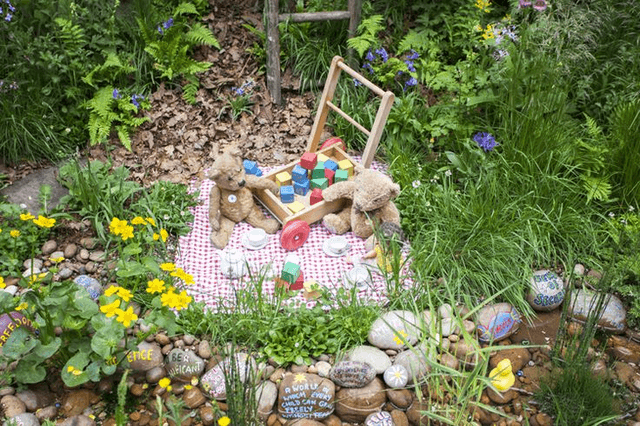NSPCC: Legacy-themed Garden of Magical Childhood
- Exhibited by
- Claire Routley
- Added
- May 09, 2016
- Medium of Communication
- Event, broadcast, press
- Target Audience
- Individuals and corporate supporters
- Type of Charity
- Children, youth and family
- Country of Origin
- UK
- Date of first appearance
- May 2013
SOFII’s view
This project was a brilliant example of cross-team working and integrated thinking. It was based on insight into the interests of those supporting The National Society for the Prevention of Cruelty to Children (NSPCC). The result was a charming garden that generated lots of interest at the Royal Horticultural Society (RHS) Chelsea Flower Show in 2013 and won a prestigious silver gilt RHS medal.
Summary / objectives
Capturing the theme of ‘inheritance’, the garden aims to encourage contemplation on the preciousness of childhood and what we wish to leave as a legacy for all children.
Background and Results
The idea for the garden was rooted in the insight that gardening was one of the primary interests of NSPCC supporters. Chelsea therefore provided the charity with a fantastic opportunity to talk to 157,000 attendees who were in the prime demographic for legacy giving.
Woolcott and Smith Garden Design wanted to produce a garden of childhood, a nostalgic place of happy memories and adventures. The aim was to encourage people to reflect on childhood, its preciousness, children’s vulnerability and how we should provide a safe and happy environment for children today and tomorrow. And part of this was to urge people to think about how they can help the NSPCC achieve this through leaving gifts in wills. Hence the message ‘What will we leave?’ from the NSPCC's own legacy campaign.
The project was a brilliant example of cross-team working and integrated thinking within the NSPCC:
- Messages displayed in the garden were generated through an email to the charity's existing supporter base of 365,000.
- A new corporate supporter, Sheila’s Wheels, was found to sponsor the garden, a relationship that can be taken forward by the corporate team.
- A major donor reception was held at the garden, providing an opportunity for the team to add value to their supporters, whilst also exposing them to the legacy message (two major donors subsequently made a pledge).
- 28 celebrities and even a royal supporter visited the garden.
- The garden achieved positive public relations coverage, which was seen by an estimated 232 million people!
Merits
Top lessons learned:
- When looking to find an innovative way to talk to legacy supporters, begin with supporter insights: what do you know about your supporters, their needs, motivations and interests?
- The cross-team working element of this project worked so well because they met the needs of other teams, from providing a high-quality event for major donors, to a great opportunity to achieve positive press coverage. When trying to achieve integration, rather than starting with the legacy team's needs, try starting with those of your colleagues.
Other relevant information
This case study was presented at an I Wish I’d Thought of That (IWITOT) session for the Chartered Institute of Fundraising (CIOFO) Legacy special interest group, in January 2016.



















